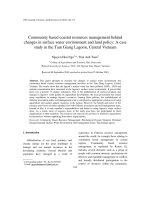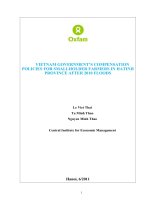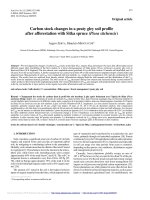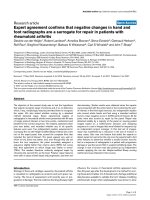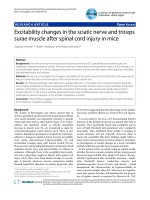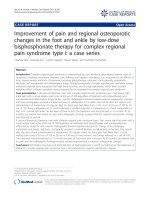Changes in personal income after land expropriation for industrial parks: Influential factors and policy recommendations
Bạn đang xem bản rút gọn của tài liệu. Xem và tải ngay bản đầy đủ của tài liệu tại đây (477.47 KB, 7 trang )
RESEARCHES & DISCUSSIONS
CHANGES IN PERSONAL INCOME AFTER LAND
EXPROPRIATION FOR INDUSTRIAL PARKS: INFLUENTIAL
FACTORS AND POLICY RECOMMENDATIONS
by Assoc. Prof., Dr. ĐINH PHI HỔ* & MEcon. NGUYỄN HUỲNH SƠN VŨ**
As more and more industrial parks are being constructed, compulsory purchase of
land for this purpose has been carried out all over Vietnam, especially in rural
areas. Those households whose land was expropriated are now facing changes in
their resources of livelihood. For a sustainable development of industrial parks and
for industrialization’s sake, proper care should be given to the living standards and
income of expropriated residents. One primary principle of land expropriation is to
guarantee that the expropriated people‘s life and income will be improved, or at
least as good as they were. Finding out about changes in their income and
influential factors to it is a challenge which scientists and policy-makers must
overcome as it provides scientific grounds for compensation policies for expropriated
people. The authors built a model of Binary Logistic Regression out of the theoretical
framework on sustainable livelihood and reality in Vietnam with a view to
quantifying the influential factors to the expropriated households’ income. To apply
and test the model in practice, a survey was conducted directly on 94 households
whose land was zoned for Tân Phú Trung Industrial Park located in Củ Chi District
of HCMC. The result shows that there are six elements affecting a household’s
income: (1) the householder’s educational background, (2) the number of laborers per
household, (3) use of compensation payments, (4) new jobs from industrial park, (5)
the dependency ratio, (6) the area of expropriated land.
Keywords: industrial park, land expropriation, Binary logistic regression.
1. Introduction
The building and expansion of industrial
parks (IP) have brought with them a modern
infrastructure, helped tap various sources of
capital and played an important role in the GDP
growth, changes in structure of industry, creation
of new jobs and sources on income. Land
expropriation
for
industrial
development,
therefore, is progressing rapidly across the
country. In the 2001-2007 period, the total area
of agricultural land which was expropriated for
non-agricultural purposes amounted to 500,000
ha. If one hectare of the land affected 10
agricultural laborers [3], then the land
expropriation during the past seven years had its
effect on the lives of five million laborers.
Numerous researches have been done on the land
clearance and compensation in IPs, but little
attention has been paid to changes in the
expropriated people’s life and income, especially
the quantifying of the influential factors to their
income. As a result, it is a tough task for
researchers and policy-makers in Vietnam to
identify them. In doing so, the authors carried
out a case study in HCMC’s Củ Chi Districtbased Tân Phú Trung IP to seek practical
evidence. This paper is to deal with (1)
* Univeristy of Economics-HCMC
**VCP Chapter of Hóc Môn District (HCMC)
Economic Development Review – July 2011
31
RESEARCHES & DISCUSSIONS
constructing a quantitative model of the
influential factors to changes in people’s lives
after land expropriation and (2) offering policy
recommendations.
2. Theoretical basis and research model
a. Theoretical basis:
By the Land Law [5], land expropriation is
the government’s decision to retrieve land and
land use right under local authorities’
management.
Land
expropriation
and
displacement can cause severe damage to the
economy, society and environment if not
planned
carefully.
According
the
Asia
Development Bank (ADB), since such damage
is inevitable, expropriation projects should be
accompanied by prior planning and treated as
a development program. The bank also points
out that those affected by land expropriation
should be given support to enhance, or at least
recover, their living standard (ADB, 1995) [1].
According to the World Bank (2004) [6], income
recovery is an important part of a land
expropriation policy because of the loss of jobs,
business profits or other income suffered by the
expropriated people. Here are some ways to
create income: (i) Offering direct credit to
small-sized and self-employed businesses; (ii)
Developing skills through training; (iii)
Providing support in finding jobs in stateowned and private companies; (iv) Giving
priority
to
expropriated
laborers
in
recruitment. In a broader sense, not only
income but also stable livelihood should be
improved for those influenced by compulsory
purchase or expropriation of land. A livelihood
consists of abilities, assets (including social and
physical capital) and activities to earn a living
(DFID, 1999) [2].
A livelihood is sustainable when it can cope
with and recover from stresses, shocks and
maintain or enhance its capacities and assets
both now and in the future, while not
undermining the natural resource base (Tim
Figure 1: Analysis of sustainable livelihoods
Policies&
institutions:
compensation,
subsidies and
resettlement
Industrialization
and urbanization
Livelihood strategies:
- Agricultural
- Non-agricultural
Influences
and
accessibility
Vulnerability context:
- Loss of agricultural
land
- Livelihood changes
- Lifestyle changes
- Increased population
density
Livelihoods assets:
Human
capital
Natu-ral
capital
Social
capital
Physical
capital
Financial
capital
Source: Based on the sustainable livelihoods framework (DFID 1999)
32
Economic Development Review – July 2011
Livelihood
outcomes:
- Increased income
- Increased stability
- Reduced risks.
RESEARCHES & DISCUSSIONS
Hanstad, Robin Nielsn and Jennifer Brown,
2004) [4]. As shown in Figure 1, a compensation
policy creates sustainable livelihoods if it affects
livelihoods assets (human, social, physical,
financial and natural capital) and combines with
changes in means of livelihood (agriculture and
non-agriculture) to guarantee better income after
land expropriation.
b. Quantitative model:
In reality, some households enjoy higher
income after getting compensation payments for
land expropriation. However, some others do not
have their income increased, and even suffer
some decrease. Thereby, the authors propose the
following Binary Logistic regression model in an
attempt to find out about influential factors to
probability of improving the income of peasants
after land expropriation:
Y 1
Ln
0 1 X 1 2 X 2 3 X 3 .. iXi
(Y 0)
P(Y=1) = P0: Probability of increased income
(improved income)
P(Y = 0) = 1- P0: Probability of non-increased
income (non-improved income)
Xi: Independent variables
0
Ln
0 1 X 1 2 X 2 3 X 3 .. nXn
1 P 0
P
P(improvedincome)
O0 0
1 P0 P(non improvedincome)
(Odds coefficient)
LnO 0 0 1 X 1 2 X 2 3 X 3 .. nXn
The log of the Odd coefficient is a linear
function with independent variables Xi (i =1,
2…n)
Based on the analysis of sustainable
livelihoods framework and the characteristics of
Vietnam’s rural areas, the following variables are
selected for the model:
The Binary logistic regression function that
identifies influential factors to the probability of
improving people’s income can be rewritten as
follows:
LnO0 = 0 + 1*edu + 2*TuoiCh+ 3*Tlpthuoc +
4*ldong + 5*dtñth + 6*(D-invest)+ 7*(D-Ldong) +
3. Results
In order to apply the model in practice,
authors conducted in December 2010 a survey of
94 households (10% of the total households)
Table 1: Influential factors to peasants’ income after land expropriation
Variable
Dependent variable
Householder’s
education
Symbol
Y
Definition
Dummy variable equaling 1 when income increases and
0 otherwise.
The number of schooling years
Number of laborers
per household
Edu
(X1)
TuoiCh
(X2)
tlpthuoc
(X3)
ldong
(X4)
Area of expropriated
land
Dtdth
(X5)
The area of agricultural and non-agricultural land
expropriated
D-Invest
X6
Dldong
X7
Dummy variable equaling 1 when compensation is
spent on business activities, and 0 otherwise
Dummy variable equaling 1 when members of a household
work in Taân Phuù Trung IP, and 0 otherwise.
Householder’s age
Dependency ratio
D-Invest
D-Ldong
The age of the householder
The ratio of the non-working members to the total
population of a household
The number of laborers per household
Unit
Expected
sign
Year
+
Year
+
%
-
Person
+
m2
+
+
Economic Development Review – July 2011
33
RESEARCHES & DISCUSSIONS
whose land was taken away for development of
the Taân Phuù Trung IP in Cuû Chi District, HCMC.
Construction of the 552.3-hectare IP affected the
lives of some 900 households. As most of them
received compensation in 2006, the comparison of
their income before and after the land
expropriation is based on the data collected in
2006 and 2010.
Then the inflation rate
announced by the GSO is employed to convert
income of 2006 to that of 2010 for making the
comparison.
a. Changes in income:
Table 2: Evaluation of income changes after
land expropriation
Number of
households
Percentage
Increased
35
37.23
Non-increased
Consisting of:
Unchanged
59
62.76
40
42.55
19
20.21
94
100.00
Changes
Decreased
Total
Source: Authors’ survey and calculations
Table 2 shows that 37.23% of the surveyed
households confirm a rise in their income,
42.55% reveal that their income remained
unchanged and the other 20.21% say that their
income decreased after the land expropriation.
However, it is necessary to take inflation rate
into account in order to gain some insight into
income changes.
As can be seen in Table 3, the income of all
households increased if not adjusted to inflation.
Specifically, after land expropriation, the
increased income group enjoyed a per capita
income rise from VND9,032 million to
VND19,076 million (up by VND10,044 million).
As for the non-increased income group, their per
capita income was VND12,551 million, up by
VND1,873 million.
After adjustment to inflation, however, the
real income of the households changed greatly.
That is, the income after land expropriation rose
only VND5,086 million for the increased income
group and decreased VND3,988 million for the
non-increased income group. Therefore, if local
authorities do not take appropriate measures to
support those households, then it is very hard to
observe the primary principle of land
expropriation. It is the case when their real
income falls, althought its absolute value rises.
b. Factors affecting changes in income:
- Table 4 indicates that if the significance
level of the Wald test is <0.05, most of the
varibles are statistical significant except for the
variable “Householder’s age” (with its significance
> 0.05)
Table 3: Average personal income among expropriated households
Household group
Before
expropriation
(VND1,000)
1. Before adjustment to inflation
- Households with increased income
- Households with non-increased
income
2. After adjustment to inflation
- Households with increased income
- Households with non-increased
income
Source: Authors’ survey and calculations
34
Economic Development Review – July 2011
After expropriation
(VND 1,000)
Comparison
±#
%
9,032
19,076
10.044
111.2
10,677
12,551
1.873
17.5
13,990
19,076
5.086
36.4
16,539
12,551
-3.988
-24.1
RESEARCHES & DISCUSSIONS
Table 4: Estimation of Binary logistic regression model
Variable
Constant (C)
Householder’s education
Householder’s age
Number of laborers per households
Dependency ratio
Area of expropriated land
Dinvest
Dldong
Omnibus test
coeffient
-3.169
0.308
0.003
1.040
-3.619
-0.0004
1.821
1.428
Chi-square
51.784
Wald
2.444
7.044
0.008
7.765
3.994
8.376
6.179
3.947
Sig.
0.000
Sig.
.118
.008
.929
.005
.046
.004
.013
.047
Exp(B) e
0.042
1.361
1.003
2.830
0.027
0.999
6.179
4.171
Dependent variables: Household type (Increased income group = 1; non-increased income group = 0)
- The Omnibus test shows that the theoretical
model is fit if its significance is over 95%.
- With other factors remaining unchanged, an
increase of one laborer per household means a
Table 5: Estimate of probability of improving income
Marginal impact
coefficient (eBk)
Householder’s education
Number of laborers in household
Dependency ratio
Area of expropriated land
Dinvest
Dldong
1.361
2.830
0.027
0.999
6.179
4.171
Table 5 indicates the probability of improving
income under the marginal impact of each factor
with the assumption that the initial probability
is 10%.
- For the variable “Householder’s education”, a
rise of one schooling year increases the probality
to 13.13%, supposing the initial probability is
10%. The figure climbs to 25.37% and 36.82% if
the initial probability is 20% and 30%
respectively. Thus, one schooling year increases
the probability by 3.13% with the initial
probability being 10%.
Similarly, here is how the other varibales are
interpreted:
- If the dependency ratio rises by 1%, the
probability falls from 10% to 0.3%.
Probability of improving the income estimated when
independent variable changes one unit – and initial
probability (%)
10%
20%
30%
13.13
25.37
36.82
23.89
41.39
54.76
0.30
0.67
1.14
9.99
19.98
29.98
40.63
60.63
72.53
31.62
50.99
64.07
rise in the probability from 10% to 23.89%.
- With other factors remaining unchanged, an
increase of 1m2 in expropriated land makes the
initial probability fall from 10% to 9.99%.
- With other factors remaining unchanged,
reasonable use of compensation payments (such
as investing them in businesses) makes the
probability rise from 10% to 40.67%.
- Employment opportunities offered by taân
Phuù Trung IP help increase the probability to
31.62%.
The influential factors in the order of their
importance are: the use of compensation, jobs
supplied by IP, the number of workers per
household, the dependency ratio, householder’s
educationa and the area of expropriated land.
Economic Development Review – July 2011
35
RESEARCHES & DISCUSSIONS
The Binary logistic regression function
identifies influential factors to the probability of
improving income is as follows:
LnO0 = -3.169 + 0.308edu – 3.619Tlpthuoc +
1.040ldong – 0.0004dtñth +1.821(D-invest) + 1.428(DLdong) +
4. Policy recommendations
The results of the model reveals that there are
four factors which increase the probabability of
improving the income of the expropriated people,
namely the householder’s education, the number
of laborers per household, effective use of
compensation payments and job opportunities
from the IP. The dependency ratio and the area
of expropriated land, meanwhile, decrease the
probability. Therefore, proper care should be
given to the following aspects:
a. Land expropriation and compensation:
Land expropriation greatly affects people’s
lives and means of livelihood and diminishes
the probability of improving their income. In
fact, expropriated residents suffer heavy losses
due to development of IPs and new urban
areas. Hence, authorities should carry out
policies on land expropriation as recommended
by international agencies. Otherwise, this can
plant the seeds of social unrest. In reality,
plenty of mass lawsuits were filed on this issue.
The
surveyed
households
say
that
compensation levels are much lower than
market prices. As a result, the compensation
for future land expropriation should be adjusted
as close to the market prices as possible. This
task could be assigned to the invisible hand of
the market; that is, compensation is
determined on the basis of agreement between
the land owner and the investor.
In carrying out a project related to land
expropriation, it is necessary to prepare local
residents for the project, help them take part in
preparation and implementation of the project
because it influences directly their livelihoodd.
Besides, there should be plans on recovering
their income.
b. Education:
36
Economic Development Review – July 2011
The survey reveals that 84.1% of the
householders and 70% of the laborers
investigated received a junior secondary
education at most, and some of them got no
education at all. Nowadays, schooling is very
essential for acquiring increased income. The
more education workers obtain, the more likely
they are to have good jobs and sufficient income.
Authorities should encourage and facilitate
people’s schooling, especially the expropriated
households’. Apart from families who earn
better income after land expropriation and can
afford to send their children to school, many
ones are put at a disadvantage for education
due to their wrong use of compensation. Hence,
reduction or exemption from school fees for
poor and expropriated families can solve the
problem.
c. Population and employment:
In the survey, 233 out of 418 respondents
are in working age and the average number of
laborers per household is 2.48. The average
dependency ratio is 44.3%. Besides, a
difference is seen in the employment structure
between households with increased income and
non-increased income. Thus, authorities should
take measure to enhance awareness of birth
control (there should be no more than two
children per family). This will decrease the
number of dependants and help them increase
their personal income.
Employment after land expropriation is a
major concern for relevant residents, for it
directly affects their lives. So vocational training
classes and job opportunities should be provided
for the local laborers affected by IP development
projects, especially those who are forced to
change their jobs because of loss of farming land.
In addition, project investors should give them
preference in recruitment.
d. Regarding the use of compensation
payments:
The
research
shows
that
spending
compensation properly, for example on doing
business, considerably contributes to improving
the income of the expropriated households.
RESEARCHES & DISCUSSIONS
According to the survey, however, compensation
is mainly used for building houses by 84.04% of
the surveyed households and for purchasing
home furnishings by 87.23%. Meanwhile, only
31.91% and 11.7% of the households spend the
money on business activities and building
boarding houses respectively.
To deal with this problem, when paying
compensation to the households, authorities
should hold consultative workshops as to how to
spend it appropriately so that they will not place
much emphasis solely on building houses and
consumer goods. Moreover, profits from IP
development projects should be shared with the
households, such as selling IP shares to these
households based on the proportion of their
expropriated land, which further helps sustain
the lives of their families.
e. Further application of the model:
In addition to its application to the land
expropriation in Tân Phú Trung IP, the model
can be employed for other IPs with larger
samples to enhance the reliability of policy
recommendations, thereby offering scientific
arguments about and better solutions to
sustainable
livelihood
and
income
for
expropriated households
References
1. Asia Development Bank (1995), Resettlement
Handbook, from
/>esettlement_Handbook_VN.pdf
2. Department for International Development (DFID,
1999), Sustainable Livelihoods Guidance Sheets, available
at: />3. Đình Long (2010), “Để nông dân ly nông nhưng bất ly
hương” (Helping peasants do non-farming businesses
without leaving their home districts), from
/>9917
4. Hanstad, Tim, R. Nielsen & J. Brown (2004), Land
and Livelihoods - Making Land Rights Real for India’s Rural
Poor, Rural Development Institute (RDI) USA, available at:
/>5. Vietnam’s National Assembly (2003), Luật đất đai
năm 2003 (Land Law 2003), from
/>=33818
6. Work Bank (2004), Involuntary Resettlement
Sourcebook Planning and Implementation in Development
Projects, available at: />DSP/IB/2004/10/04/000012009_20041004165645/Render
ed/PDF/301180v110PAPE1ettlementosourcebook.pdf
Economic Development Review – July 2011
37


